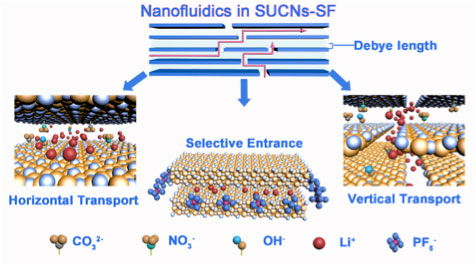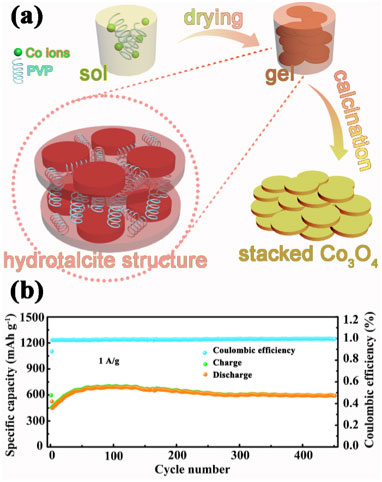| Posted: Dec 08, 2017 | |
Engineering 2D nanofluidic channels for energy storage application |
|
| (Nanowerk Spotlight) Despite being a promising electrode material, bulk cobalt oxide (Co3O4) exhibits poor lithium ion storage properties. Nanostructuring, e.g. making Co3O4 into ultrathin nanosheets, shows improved performance, however, Co3O4-based nanomaterials still lack long-term stability and high rate capability due to sluggish ion transport and structure degradation. | |
| Nanofluidics channels possess desired properties to address above issues. However, while these unique structures have been studied in hollow nanotubes and recently in restacked layered materials such as graphene, it remains challenging to construct nanofluidic channels in intrinsically non-layered materials. | |
| Motived by the large number of non-layered materials, e.g. transition metal oxides, which hold great promise in battery applications, scientists aim to extend the concept of nanofluidic channels into these materials and improve their electrochemical properties. | |
| Nanofluidic channels feature a unique unipolar ionic transport when properly designed and constructed. By controlling surface charge and channel spacing, enhanced and selective ion transport can be achieved in these channels by constructing them with dimensions comparable to the double Debye length and opposite surface charge with respect to the transporting ion. | |
| In a new study published in Advanced Materials ("Engineering 2D Nanofluidic Li-Ion Transport Channels for Superior Electrochemical Energy Storage"), researchers have developed a Co3O4-based two-dimensional (2D) nano-architecture possessing nanofluidic channels with specially designed interlayer characteristics for fast lithium ion transport, leading to exceptional performance in lithium ion batteries ever reported for this material. | |
| "Such constructed 2D nanofluidic channels in non-layered materials manifest a general structural engineering strategy for improving electrochemical properties in a vast number of different electrode materials," Guihua Yu, a professor in Materials Science and Engineering, Mechanical Engineering, at the Texas Materials Institute, University of Texas at Austin, tells Nanowerk. "The enhanced and selective ion transport demonstrated in our study is of broad interest to many applications where fast kinetics of ion transport is essential." | |
 |
|
| Illustration of lithium ion transport in 2D nanofluidic channels. (Reprinted with permission by Wiley-VCH) | |
| On the one hand, an intercalated molecule acts as interlayer pillar in the stacked oxide, constituting transport channels with proper spacing. On the other hand, negatively charged functional groups anchored on the nanosheets surface facilitate transport of positively charged lithium ions inside the channels. | |
| "Satisfying aforementioned conditions for unipolar ionic transport, combined with other advantageous features – extra storage capacity contributed by the surface functional groups, buffered structural stress from the interlayer spacing, and shortened lithium ion diffusion distance due to the ultrathin nanosheet morphology – the resulting nanoarchitecture exhibit exceptional electrochemical performance as tested in lithium-ion batteries," notes Yu. | |
| In a next step, the researchers are going to extend the concept of 2D nanofluidic channels to other electrode materials with or without layering structures. With ability to further tune interlayer spacing, they expect some promising energy storage applications in beyond-lithium-ion batteries. | |
| It might also be interesting to examine this structural engineering strategy in other applications, for example, catalysis. | |
 |
|
| Design and LIBs application of Co3O4 nanosheets with 2D nanofluidic channels. (a) The synthetic route from Co-based layered hydroxide precursor to Co3O4 nanosheets with 2D nanofluidic channels. (b) Cycling performance of a full cell (anode: Co3O4 nanosheets /cathode: commercial LiCoO2). (Reprinted with permission by Wiley-VCH) | |
| Constructing 2D nanofluidic channels for energy storage application is still in its infancy and the success of using non-layered materials demonstrated in this study promises a bright future in this direction with a broader material coverage. | |
| "We are also taking this research direction even further by looking into the transport and storage properties for energy storage systems based on larger charge-carrying ions, such as Na+ and Mg2+, " concludes Yu. "In order to realize that, an important challenge is to tune the channel spacing in a controlled manner. It is also imperative to investigate structural stability and scalability of this specially designed nanoarchitecture for its utilization in practical applications." | |
 By
Michael
Berger
– Michael is author of three books by the Royal Society of Chemistry:
Nano-Society: Pushing the Boundaries of Technology,
Nanotechnology: The Future is Tiny, and
Nanoengineering: The Skills and Tools Making Technology Invisible
Copyright ©
Nanowerk LLC
By
Michael
Berger
– Michael is author of three books by the Royal Society of Chemistry:
Nano-Society: Pushing the Boundaries of Technology,
Nanotechnology: The Future is Tiny, and
Nanoengineering: The Skills and Tools Making Technology Invisible
Copyright ©
Nanowerk LLC
|
|
|
Become a Spotlight guest author! Join our large and growing group of guest contributors. Have you just published a scientific paper or have other exciting developments to share with the nanotechnology community? Here is how to publish on nanowerk.com. |
|
